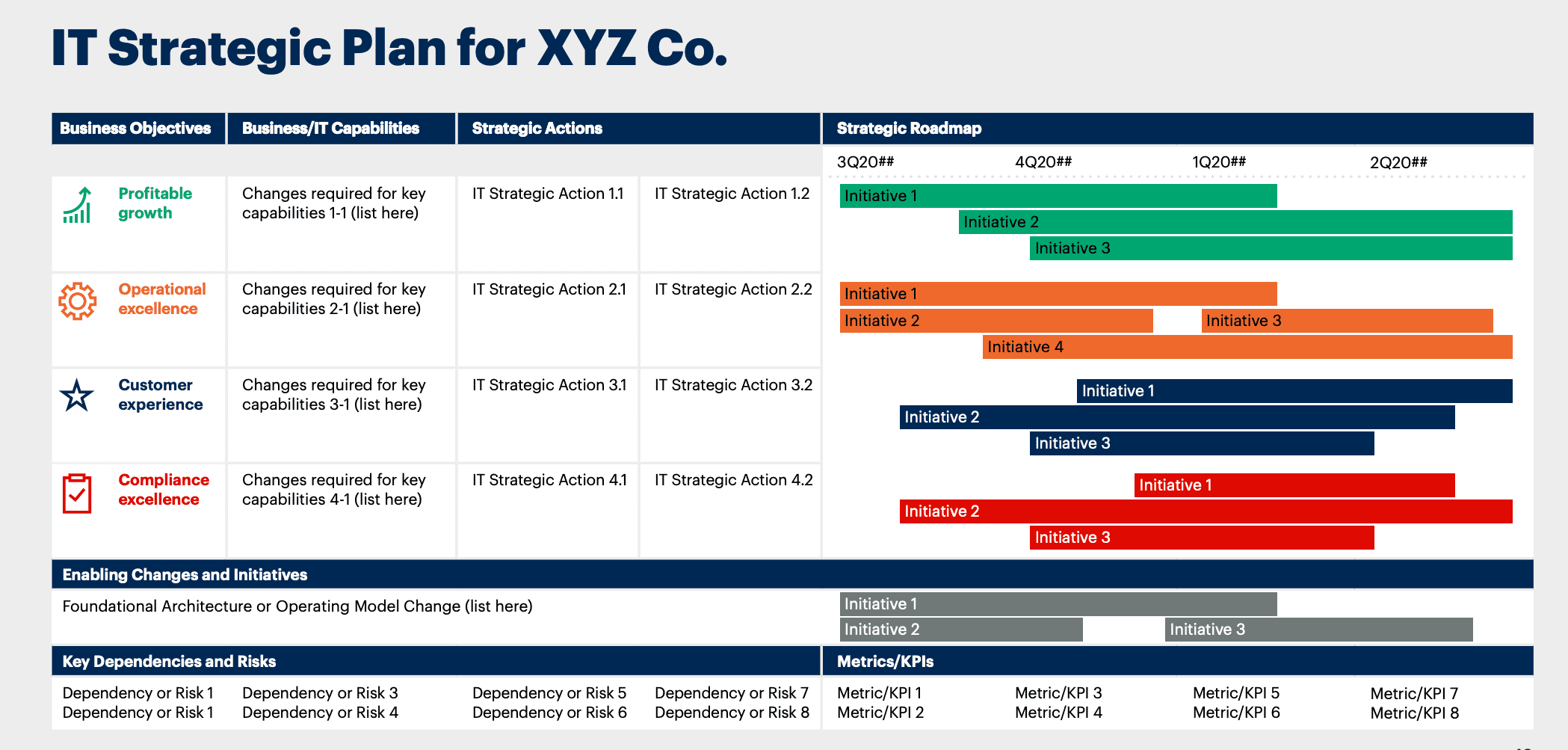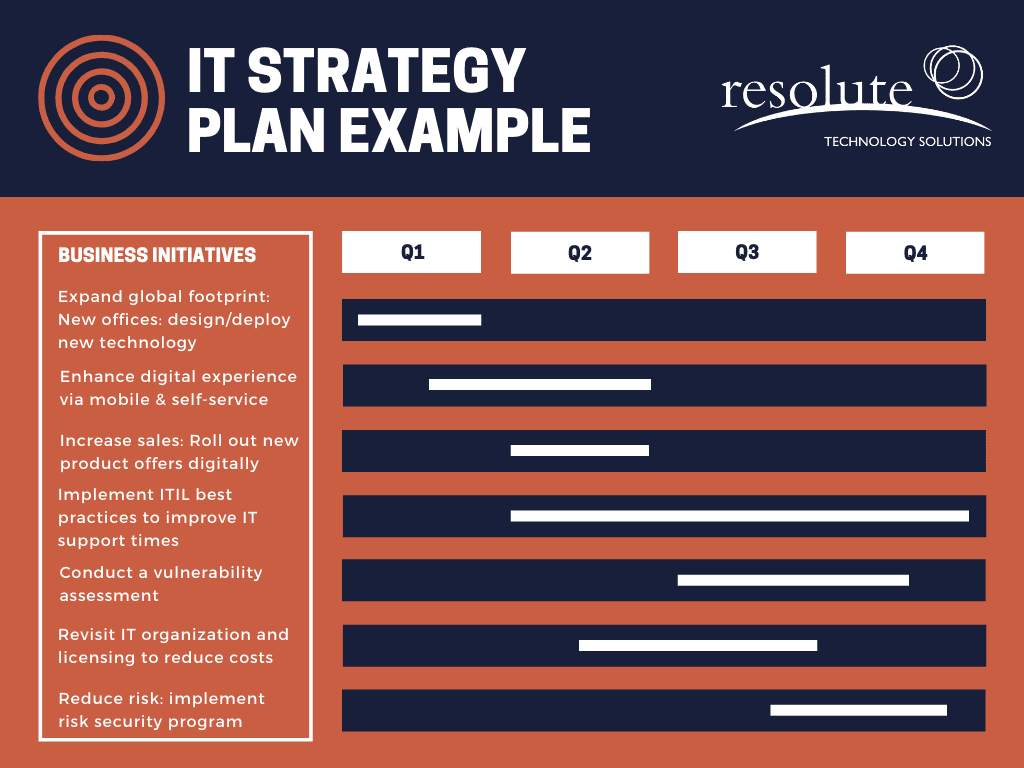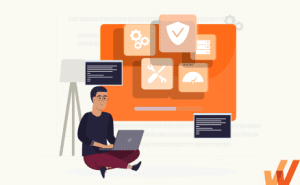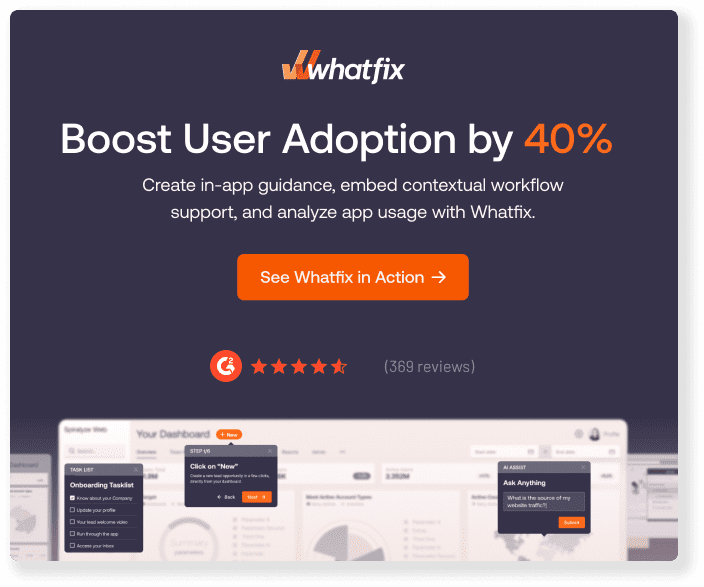In 2025, digital transformation is not a future ambition; it’s a business mandate. CIOs and IT leaders are now responsible for driving enterprise agility, orchestrating technology investments, and embedding AI and automation at scale. Yet many organizations treat planning as an isolated IT function, focusing on deliverables instead of outcomes, or mistaking tactical fixes for long-term strategy.
A modern IT roadmap repositions planning as a cross-functional business asset. It ensures that every decision to implement new technologies aligns with strategic goals, governance frameworks, and measurable performance indicators. It also integrates ITIL change management to support continuous evolution, user adoption, and organizational resilience.
This guide explores creating a modern, AI-ready IT strategic plan that connects vision with execution, avoids common pitfalls, and embraces the trends shaping the next generation of enterprise technology.
What Is an IT Strategic Plan?
An IT strategic plan is a multi-year blueprint that details how technology initiatives will deliver on the organization’s business goals, driving growth, operational resilience, and enterprise-wide transformation. More than a backlog of IT projects, it’s an integrated roadmap that aligns digital investments with measurable business outcomes, ensuring that innovation is delivered with structure, accountability, and scale.
A strategic plan, typically three to five years, outlines how the organization will implement new technologies, manage emerging risks, and lead cross-departmental change. These plans must be flexible—living documents capable of evolving with customer expectations, regulatory demands, and innovations like AI, RPA (robot process automation), and low-code platforms.
IT strategic plan vs. IT strategy
An IT strategy defines the overarching vision for how technology enables business success. In contrast, an IT strategic plan translates that vision into execution. It outlines the steps, governance structures, timelines, and performance metrics required to implement the strategy and track its outcomes.
For example, if your strategy involves a cloud migration, the strategic plan clarifies how that happens—what workloads migrate first, how regulatory compliance is ensured, how teams are prepared for new workflows, and how KPIs are established to measure success.
Benefits of Strategic IT Planning
Strategic IT planning today is less about managing day-to-day operations and more about creating the conditions for business agility, innovation, and enterprise-wide value. When executed effectively, it repositions IT from a support function into a strategic enabler, empowering purposeful technology adoption, fostering cross-functional collaboration, and improving enterprise resilience.
A well-executed IT strategic plan delivers the following benefits:
- Organizational agility in the face of change: A structured plan enables teams to adapt quickly to evolving market demands, new technologies, or operational disruptions, without losing sight of long-term objectives.
- Precision alignment with business priorities: Every IT initiative is tied to clearly defined outcomes, improving clarity, accountability, and executive confidence in technology investments.
- Smarter resource allocation: IT plans optimize how funds and resources are directed toward transformation by prioritizing high-impact projects and reducing legacy spending.
- Stronger data security and regulatory posture: Governance frameworks embedded in the plan help proactively address cybersecurity risks, ensure compliance, and safeguard stakeholder trust.
- Accelerated technology adoption and innovation: Strategic planning nurtures a culture of experimentation and continuous improvement, driving technology adoption and supporting business process transformation.
- Cross-functional collaboration at scale: IT planning breaks down silos, ensuring alignment and transparency across departments during the implementation of enterprise-wide initiatives.
- Proactive risk mitigation: Identifying risks early, whether related to vendors, compliance, or system capacity, helps embed resilience into transformation initiatives.
- Ongoing business process transformation: Strategic IT planning serves as a catalyst for reengineering workflows, integrating automation, and enabling long-term scalability.
8 Elements of a 2025-Ready IT Strategic Plan
A modern IT strategy isn’t just a vision document; it’s a living, execution-ready framework that enables technology leaders to scale transformation, manage risk, and deliver measurable value. Close alignment with business priorities is required while remaining agile in the face of compliance shifts, emerging technologies, and change implementation.
The following eight elements combine structural components (“what”) with the procedural stages (“how”), merging strategy design and lifecycle execution into a unified model. Together, they enable CIOs and digital leaders to build IT plans that are not only comprehensive but also actionable, adaptive, and accountable.
1. Current-state analysis
Every strategic IT plan starts by diagnosing the current state. This involves mapping the existing digital ecosystem—including platforms, processes, infrastructure, and workforce capabilities—to uncover gaps, inefficiencies, and overlooked strengths.
A comprehensive current-state analysis draws from multiple inputs: stakeholder interviews, IT audits, infrastructure reviews, and focus groups. These diagnostics provide a baseline that ensures the strategy is built on operational truth (not assumptions), enabling more accurate forecasting, prioritization, and execution planning.
Use case: A media company preparing for AI integration begins with a deep audit of its content management systems. The review surfaces outdated APIs, skill gaps in the development team, and fragmented data quality—all of which must be addressed before the new tooling can be adopted.
2. Vision & goals alignment
With a clear understanding of the current state, the next step is to align IT initiatives with the organization’s broader strategic vision. This ensures technology investments enable (not distract from) core business outcomes like growth, efficiency, and innovation.
Strategic alignment is not about generic tech upgrades; it’s about ensuring initiatives like data modernization, process automation, or cloud enablement support specific enterprise priorities. This is also where change management becomes essential: it provides the structure needed to integrate technology into business workflows with minimal resistance to change and better long-term adoption.
Example: A multinational healthcare provider aligns its IT vision with its business goal of expanding telehealth services. The team prioritizes secure mobile access, real-time video infrastructure, and patient data integration, directly supporting clinical and operational expansion across regional markets.
3. Roadmap & timelines
An IT roadmap is the operational bridge between strategic vision and tactical delivery. It sequences key initiatives over a multi-year timeline, accounting for dependencies, resource constraints, and enterprise-wide priorities. This includes initiatives like software implementation and legacy application modernization, frequently delivered in stages across quarters or fiscal years.
An effective, outcome-based IT roadmap balances short-term wins with long-term goals and provides flexibility for mid-course corrections. It helps technology leaders manage expectations, optimize delivery schedules, and coordinate across distribution teams and overlapping workstreams—especially critical in complex, multi-system environments.
Consider this use case: A financial services firm rolls out a 24-month roadmap to migrate core banking systems to the cloud. Each phase is calibrated around compliance milestones, peak transaction volumes, and capacity planning constraints, ensuring minimal service disruption and regulatory alignment.
4. Change management strategy
No IT initiative succeeds without user adoption. A robust change management strategy ensures that technology rollouts are supported with structured communication, training, and engagement tactics. It addresses cultural resistance, shifts in roles and responsibilities, and process disruption—so users feel empowered, not blindsided.
Key elements include a structured change communication plan, stakeholder analysis, training timelines, and a RACI matrix (responsible, accountable, consulted, informed) to clarify change ownership across the organization. In 2025, digital adoption platforms like Whatfix DAP can enhance this by embedding role-based in-app messaging and in-context prompts that help teams adopt and consistently perform new digital tasks in existing tools.
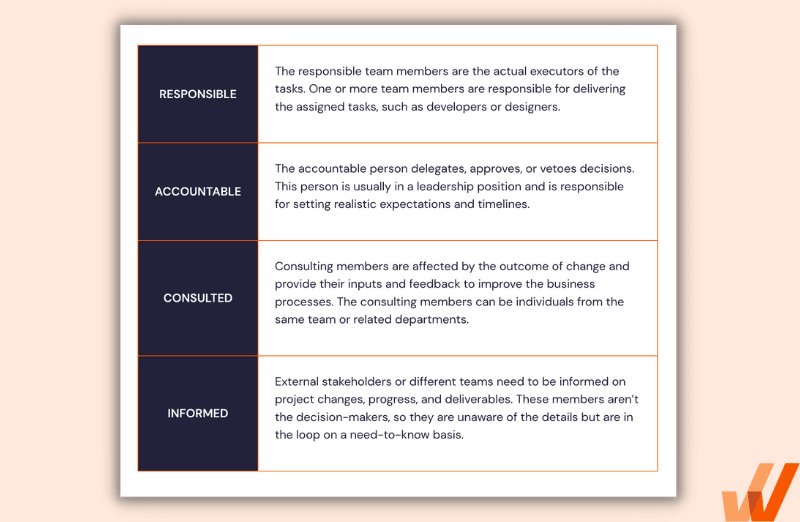
Use case: A large organization is launching a new internal HCM. They create a role-based communication rollout plan and use a digital adoption platform to enable its people with in-app guidance within the product UI to drive faster onboarding, reduce support tickets, and help them realize value from the new HCM transformation project faster
5. Governance & security
Governance provides the guardrails that keep IT aligned with compliance, security, and operational standards. This includes defining decision-making structures, setting data policies, managing risk, and embedding cybersecurity best practices throughout the IT lifecycle.
With rising regulatory scrutiny and increasing complexity from hybrid environments, IT governance must be embedded in every layer of the strategy. It ensures transparency, reduces liability, and enables confident scaling. To operationalize this, organizations often adopt IT frameworks—such as ITIL, COBIT, or TOGAF—which help formalize governance processes, enforce policy consistency, and align IT operations with broader enterprise standards.
Use case: A global logistics company develops a governance framework to standardize vendor contracts, track system access, and enforce GDPR compliance across regional operations. Audits and performance reviews are automated and linked to IT leadership dashboards.
6. KPIs & metrics
Without measurement, strategy is speculation. Defining clear, outcome-driven KPIs allows IT teams to track progress, identify bottlenecks, and optimize performance in real time. Robust IT metrics link technology outputs to business results, tying platform uptime, cost-to-serve, or adoption rates to enterprise growth and customer experience.
Modern IT strategies go beyond surface indicators. They build dashboards that highlight what matters—project velocity, ROI, and innovation cadence—while providing transparency to stakeholders and executives.
Example: A SaaS company introduces KPI dashboards to monitor its customers’ feature usage, incident response time, and engineering throughput. These metrics inform sprint planning, roadmap decisions, and customer success priorities.
7. Implementation roadblocks
Challenges are inevitable in any transformation initiative; anticipating them is key to maintaining momentum. Identifying potential blockers (such as technical debt, change fatigue, and unclear ownership) early in the planning process can prevent costly delays and misalignment.
This element of strategic planning focuses on surfacing known and hidden risks before the implementation phase begins and building contingency plans to address them. It plays a critical role in ensuring that change implementation efforts stay on track, especially when multiple teams or systems are involved. Tools like the RACI matrix are especially useful here, clarifying roles and responsibilities so that accountability gaps don’t derail progress mid-stream.
Use case: A government agency launching a new citizen services portal identifies key roadblocks, including outdated middleware and fragmented stakeholder buy-in. By addressing both in early planning, the time to deployment is shortened by four months.
8. Review & continuous improvement
An IT strategy is never static. As technology, business priorities, and market forces evolve, so must your strategic plan. Ongoing review cycles, performance audits, and stakeholder feedback loops help refine the strategy and sustain its relevance over time.
This component reinforces agility, ensuring that insights from early wins (and failures) feed directly into roadmap updates and process optimization and help teams adapt to change as new technologies and priorities emerge.
Use case: A retail organization holds quarterly IT strategy retrospectives, adjusting timelines based on real-time customer insights and re-prioritizing initiatives based on emerging platform analytics.
Common Pitfalls & How to Avoid Them
Even the most well-designed IT strategic plans can fall short when critical gaps in planning are overlooked. These failures are rarely the result of poor intent; instead, they stem from overlooked assumptions, unclear success metrics, or gaps in ownership. As organizations push toward greater agility, automation, and AI integration, the margin for error shrinks.
This section outlines six common pitfalls in IT strategic planning and how CIOs and transformation leaders can avoid them through deliberate design, inclusive planning, and disciplined execution.
1. Siloed stakeholder involvement
When strategic planning is confined to IT or executive leadership alone, it creates blind spots in execution. Business units may be unaware of upcoming changes, or worse, feel excluded from shaping solutions that directly affect them.
How to avoid it: Engage cross-functional leaders early and often—through planning workshops, discovery interviews, and steering committees. Ensuring stakeholder buy-in upfront leads to smoother implementation and stronger adoption.
2. Undefined goals and metrics
Without clear goals and measurable outcomes, an IT strategy becomes a checklist rather than a change agent. Teams may execute projects without a shared understanding of success, leading to resource wastage or misaligned priorities.
How to avoid it: Anchor your plan to specific, outcome-driven KPIs that align with enterprise goals. Build dashboards and feedback loops to track progress and recalibrate in real time.
3. Inadequate change management planning
Many strategies fail not because the technology is wrong, but because the change is poorly communicated or unsupported. Without a structured approach to help teams adapt, even the best systems face resistance or slow adoption.
How to avoid it: Develop a comprehensive change management plan that includes communication strategies, training resources, and adoption metrics. Assign clear ownership and use tools like Whatfix DAP to support in-app learning and behavior reinforcement.
4. Lack of governance and accountability
Strategic plans that lack governance structures often struggle with scope creep, compliance gaps, or decision paralysis. Without clear accountability, initiatives stall or drift from intended outcomes.
How to avoid it: Establish governance frameworks early, define roles and escalation paths, and set regular review cadences. Use a RACI matrix to clarify ownership and ensure decision-making is distributed but structured.
5. Overlooking risk and compliance
Focusing solely on innovation can cause teams to miss critical vulnerabilities. Unaddressed risks, such as third-party risk, data residency issues, or security misconfigurations, can derail or delay execution.
How to avoid it: Integrate risk assessments and compliance reviews into the planning process, not just implementation. Ensure security, legal, and data officers are part of the strategic review cycle.
6. Neglecting ongoing measurement
Too often, plans are launched and then left to drift. Without regular review and adjustment, even well-aligned strategies can become outdated or disconnected from business requirements.
How to avoid it: Build continuous improvement into your strategy. Schedule quarterly retrospectives, monitor KPIs, and treat the roadmap as a living document that evolves with the business.
2025 Trends in IT Strategic Planning
Strategic planning in 2025 is no longer focused solely on alignment and execution—it’s about anticipation. As technologies mature and digital pressure accelerates, CIOs must build strategies that are not only responsive but predictive, resilient, and scalable. The trends below highlight where IT planning is headed—and what forward-thinking organizations are prioritizing to stay ahead.
1. AI-driven capacity forecasting
As organizations confront tighter budgets and faster cycle times, AI transforms capacity planning from reactive estimation into real-time precision. By analyzing historical data, seasonality, and operational patterns, AI-driven forecasting helps IT teams allocate resources more efficiently and predict infrastructure demand before bottlenecks occur.
By mid-2025, approximately 55% of capacity planning tools will incorporate AI or machine learning to improve forecasting accuracy and automate resourcing decisions. Yet while these capabilities are rapidly advancing, adoption lags: only 1% of companies consider themselves mature in AI deployment (according to McKinsey’s 2025 Superagency in the Workplace report).
At the same time, 87% of executives expect generative AI to deliver growth within three years, placing pressure on IT leaders to operationalize AI not just as a concept, but as a forecasting engine that drives measurable efficiency and resilience.
2. Cyber-resilience for the cloud and edge
The shift to cloud-native and edge architectures has introduced new layers of complexity and, with it, new exposure to cybersecurity risk. IT strategic plans increasingly embed cyber-resilience as a core design principle, not a post-implementation concern.
The World Economic Forum’s Global Cybersecurity Outlook emphasizes the growing sophistication of distributed threats. Moreover, Gartner predicts that by 2025, 75% of enterprise data will be processed at the edge (outside traditional data centers), intensifying the need for decentralized security planning, zero-trust architectures, and automated response protocols.
3. Low-code platforms in strategic roadmaps
Low-code and no-code platforms are central to IT execution. These tools accelerate delivery, reduce developer overhead, and allow business units to prototype and deploy internal solutions independently, with IT oversight.
According to Gartner, more than 70% of new business applications will be built using low-code or no-code technologies by 2025. As part of strategic planning, low-code capabilities are being woven into modernization roadmaps, allowing teams to digitize manual workflows, improve time-to-value, and support change implementation at scale.
IT Strategic Plan Roles & Responsibilities
An effective IT strategic plan depends not just on vision and execution, but on clearly defined ownership. Each stakeholder plays a critical role across the lifecycle, from current-state analysis through change implementation and continuous improvement. Without clear accountability, even well-designed strategies risk stalling.
Significantly, these roles aren’t limited to IT. Driving long-term success requires a coordinated effort across business units, governance leaders, and end-users—each of whom shapes how technology decisions are made, delivered, and adopted.
Below, we outline the critical roles in creating and executing an IT strategic plan and their key responsibilities.
1. Chief Information Officer (CIO)
The CIO provides executive leadership for the IT strategic plan, ensuring that every initiative reinforces the organization’s business objectives and technology roadmap. As the strategic bridge between business and IT, the CIO shapes direction, sets priorities, and drives alignment across teams.
Key responsibilities:
- Lead the end-to-end IT strategic planning process.
- Align IT strategy with enterprise goals and digital transformation priorities.
- Champion technology adoption and business process transformation.
- Allocate resources and budget in accordance with long-term objectives.
- Translate executive mandates into actionable IT roadmaps.
2. IT Director/IT Manager
The IT director or manager reports to the CIO and is responsible for operationalizing the plan. They ensure the IT team’s daily activities, infrastructure, and systems align with the strategic vision and that resources are scaled effectively over time.
Key responsibilities:
- Manage ongoing IT operations and performance.
- Execute infrastructure and software implementation projects.
- Lead legacy application modernization and platform upgrades.
- Collaborate with other departments on shared technology needs.
- Oversee team readiness, staffing, and skills development.
3. Project Manager
IT project managers translate high-level strategy into executable plans. They structure implementation timelines, track dependencies, and coordinate delivery across teams and vendors.
Key responsibilities:
- Create detailed project timelines and workstreams.
- Use a RACI matrix to clarify stakeholder roles.
- Facilitate cross-functional coordination and change implementation.
- Monitor progress, manage risk, and report on milestones.
- Maintain project alignment with roadmap and resource forecasts.
4. Change Manager
Change managers ensure that transformation is not only delivered but also adopted. They lead the organizational side of change, developing structured communication and support strategies that prepare teams for new systems, tools, or workflows.
Key responsibilities:
- Design and execute a comprehensive change communication plan.
- Manage internal resistance to change and provide user support as teams move through the change curve.
- Train staff on new systems or processes to accelerate technology adoption
- Collect feedback and adjust support materials based on real-world usage.
- Foster transparency and psychological safety during transformation.
5. IT Governance Officer
Governance officers own policy, compliance, and oversight. They ensure all initiatives adhere to legal, regulatory, and ethical standards while reinforcing internal accountability.
Key responsibilities:
- Implement and maintain IT governance frameworks (e.g., ITIL, COBIT, TOGAF).
- Define security, privacy, and compliance standards.
- Oversee risk assessments and mitigation strategies.
- Monitor audit readiness and enforce regulatory controls.
- Partner with legal, data, and security teams to align protocols.
6. Business Unit Leaders
Business unit leaders are critical for ensuring IT initiatives meet functional and operational requirements. Their input helps prioritize initiatives, align systems with real-world use cases, and build internal advocacy.
Key responsibilities:
- Provide business context and input during current-state and roadmap phases.
- Align departmental needs with technology investment priorities.
- Translate IT strategy into day-to-day operational benefits.
- Build the business case for new solutions within their teams.
- Serve as implementation champions and internal liaisons.
7. End-Users (ie, employees)
End-users—from front-line employees to middle managers—determine the success of technology adoption. Their experience, feedback, and engagement influence whether platforms and workflows actually deliver value.
Key responsibilities:
- Participate in discovery to provide usability and functionality insights.
- Engage in training programs (and onboarding) to confidently navigate new systems and workflows.
- Flag blockers and provide feedback during rollout and support phases.
- Act as early adopters and peer enablers during implementation.
- Help identify opportunities for continuous improvement.
Strategic IT Plan Use Cases
Strategic IT planning is the execution framework that drives measurable business value from technology. As McKinsey found, 87% of leaders struggle with the complexity of their existing infrastructure, which often creates bottlenecks for next-generation services. A robust IT plan helps untangle this complexity, simplifying, streamlining, and modernizing the way technology supports the business.
Below are five strategic use cases illustrating how IT planning creates tangible, high-impact outcomes.
1. Digital transformation
Digital transformation is not just about adopting the latest tools—it’s about redefining how your business functions at its core. A mature IT strategic plan enables companies to move beyond ad hoc digitization and become digitally mature organizations capable of sustained, adaptive growth.
Recent research by Accenture underscores the tangible benefits of AI-led processes in digitally mature organizations. Companies that have fully modernized their operations with AI report:
- 2.5x higher revenue growth.
- 2.4x greater productivity.
- 3.3x more success in scaling GenAI use cases.
Moreover, the proportion of organizations with fully AI-led processes nearly doubled from 9% in 2023 to 16% in 2024, highlighting a significant shift toward intelligent operations.
Examples of successful digital transformation in action:
- Integrating enterprise platforms to eliminate data silos.
- Automating manual processes to increase speed and reduce errors.
- Migrating from paper-based workflows to cloud-first systems.
- Applying advanced analytics to accelerate decision-making.
2. Digital innovation
Digital innovation thrives when organizations intentionally create space for experimentation and cross-functional collaboration. In 2025, this often includes piloting AI copilots, launching low-code platforms, or testing connected device ecosystems that can scale across business units. Strategic IT planning provides the governance and structure to support continuous innovation, ensuring emerging technologies align with business priorities.
Examples of fostering digital innovation through planning:
- Replacing outdated tools with agile, cloud-native platforms.
- Deploying new internal apps that enable modern ways of working.
- Piloting emerging technologies like AI or IoT to test new use cases.
- Leveraging RPA to optimize daily workflows and free up talent for higher-value work.
3. Managing existing IT portfolios
Most enterprises already operate within sprawling IT ecosystems. A strategic IT plan clarifies what’s working, what needs improvement, and how best to allocate resources. It shifts portfolio management from a maintenance mindset to a transformation mandate.
Examples of effective portfolio management:
- Performing a cost-benefit analysis to guide tech investment decisions.
- Redirecting funding from legacy platforms to next-gen capabilities.
- Retiring underutilized systems that slow agility or increase risk.
- Prioritizing initiatives based on long-term business value.
4. Cloud migration
Cloud migration is foundational to modern IT strategy—but it’s complex. Without a plan, cloud initiatives can stall or create security gaps. A well-structured IT roadmap ensures the migration is phased, compliant, and aligned with workforce capability.
Examples of a well-executed cloud migration planning:
- Moving data and apps from on-premises systems to AWS, GCP, or Azure.
- Adopting hybrid architectures to balance legacy and modern systems.
- Enabling remote teams with cloud-based collaboration tools.
- Reducing CapEX and operational overhead by shifting to cloud-managed services.
5. IT risk management
Risk, from ransomware to regulatory scrutiny, is an unavoidable dimension of digital transformation. A forward-looking IT strategy embeds risk mitigation and response planning across the entire lifecycle, not just at deployment.
Examples of proactive IT risk management:
- Implementing cybersecurity protocols across distributed endpoints.
- Developing and testing disaster recovery playbooks.
- Monitoring third-party software and service provider risk.
- Ensuring compliance with evolving data privacy laws like GDPR or CCPA
How to Create an IT Strategic Plan (Best Practices)
An effective IT strategic plan isn’t built in isolation; it emerges from cross-functional collaboration, clear business alignment, and a structured approach to change. These best practices reflect how leading organizations move from intent to execution, ensuring their plans are grounded, flexible, and built for impact.
The following steps will guide you through creating an effective, adaptable IT strategy.
1. Conduct a comprehensive assessment
The planning process starts with a complete understanding of the current state. This includes auditing IT infrastructure, reviewing processes and systems, and capturing insights across departments. The goal is to uncover inefficiencies, identify unmet needs, and establish a clear operational baseline.
Key activities for this phase include:
- Running surveys, interviews, and focus groups with IT and business stakeholders.
- Reviewing systems, workflows, and performance metrics to detect gaps or redundancies.
- Benchmarking against industry trends to ensure competitive alignment.
2. Align IT goals with business objectives
With the baseline in place, the next step is aligning technology initiatives with enterprise strategy. This ensures that every IT investment contributes to growth, efficiency, or innovation, and is measurable against business outcomes.
Key activities:
- Collaborating with executive leadership to map long-term strategic goals.
- Defining IT initiatives that enable these goals (e.g., operational automation, data modernization).
- Establishing KPIs that link IT deliverables to business value.
3. Develop a technology roadmap
The technology roadmap is your execution blueprint. It translates strategic intent into actionable timelines, budgets, and delivery phases—while accounting for interdependencies, compliance requirements, and resource availability.
Key activities for this phase include:
- Prioritizing initiatives based on business impact and feasibility.
- Building a phased delivery plan with checkpoints, milestones, and early wins.
- Allocating technical resources and adjusting timelines to reflect capacity constraints.
4. Assign roles and responsibilities
Strategic plan execution requires clear ownership. Defining ownership (such as who is responsible, accountable, consulted, and informed) eliminates ambiguity, accelerates decision-making, and strengthens cross-functional coordination.
Key responsibilities include:
- Creating a detailed project charter covering scope, deliverables, and stakeholders.
- Using the RACI matrix (responsible, accountable, consulted, informed) to assign roles.
- Promoting cross-functional collaboration to eliminate silos and surface blind spots.
5. Implement the plan with phased rollouts
Rather than attempting a “big bang” deployment, phased rollouts reduce risk and make it easier to refine the strategy as conditions evolve.
Best practices:
- Breaking large programs into manageable, goal-specific phases.
- Validating each phase through stakeholder feedback loops.
- Using early wins to build momentum and gain internal buy-in.
6. Monitor progress and adjust as necessary
A strategic plan is only as effective if it evolves. Tracking KPIs, gathering stakeholder feedback, and reassessing priorities ensures your strategy stays responsive to business shifts and technology trends.
Key activities:
- Monitoring performance against established KPIs and timelines
- Conducting regular stakeholder reviews to surface issues or misalignments.
- Refining the roadmap as market, organizational, or technical conditions evolve.
IT Strategy Plan Examples
There is no one-size-fits-all format for strategic IT planning. The structure, cadence, and depth of a plan will vary based on organizational size, industry maturity, and the level of digital transformation being targeted. Below are three representative templates—used by consulting firms and solution providers—that illustrate different approaches to aligning IT with business strategy:
1. Gartner’s IT Strategy Framework
Gartner’s strategic IT planning model emphasizes business alignment and execution discipline. It begins by defining enterprise goals and assessing current business and IT capabilities. This gap analysis guides the development of a phased strategic roadmap with timelines, milestones, and performance measures.
The framework also accounts for change enablement, highlighting where system upgrades, new technology adoption, or operational shifts are required. Dependencies and risks are explicitly mapped, allowing teams to anticipate roadblocks and build mitigation strategies. KPIs are embedded throughout to link execution to business outcomes.
Best suited for: Large enterprises seeking a structured, top-down model with embedded governance and risk mitigation.
2. Resolute Technology Solutions’ IT Strategy Approach
Resolute Technology Solutions applies a quarterly planning framework that breaks strategic initiatives into time-bound, measurable segments. Each quarter is tied to specific business objectives, making progress easy to track and adjust in real time.
This incremental model supports agility without sacrificing long-term focus. It helps organizations execute immediate priorities while continuously evaluating and refining the strategy based on evolving technologies and shifting business requirements.
Best suited for: Mid-size to large organizations that value agility, continuous improvement, and tactical visibility.
3. Whatfix’s IT Strategy Plan Template
Whatfix offers a comprehensive IT strategic plan template designed to drive execution readiness. It starts with a vision and mission statement and proceeds through structure stages: current-state audits, infrastructure reviews, and gap analyses.
Unique to this model is its emphasis on operational details, such as licensing, resource allocation, and security planning. It also includes a SWOT analysis, which helps contextualize internal factors like infrastructure gaps and team capabilities, alongside external forces such as market shifts, regulatory pressures, and emerging technologies. Whatfix’s approach extends through adoption, with detailed guidance on user training, onboarding, and change communication, ensuring that plans are not only designed but fully implemented.
Best suited for: Enterprises prioritizing execution, adoption, and end-user alignment in complex digital environments.
Download your free strategic IT plan template now:
7 Best IT Strategic Planning Software
Selecting the right software can make all the difference in managing and executing a successful IT strategy. These tools help IT teams align technology initiatives with business goals, streamline processes, and track performance. Below are seven top solutions that offer powerful features for IT strategic planning in 2024.
1. Cascade
- G2 Rating: 4.7 out of 5 stars
- Pricing: Free option available; contact for other pricing details
Cascade is a comprehensive tool for managing strategic planning, execution, and reporting, tailored to support IT teams in aligning their goals with broader business objectives. It allows organizations to create fully customized IT strategy plans, set measurable goals, and track progress in real time. Its user-friendly interface and strong integration capabilities make it a favorite for teams seeking a seamless way to manage their IT strategy.

Key features:
- Fully customizable strategic plans with KPI tracking
- Real-time project performance dashboards for monitoring progress
- Secure single sign-on (SSO) and advanced data encryption
- Integrates with popular business tools to streamline workflows
2. Workboard
- G2 Rating: 4.7 out of 5 stars
- Pricing: Contact for pricing details
WorkBoard stands out for its focus on driving results through Objectives and Key Results (OKRs), making it a powerful tool for aligning IT initiatives with business outcomes. Its collaborative platform fosters accountability and transparency across teams, allowing IT leaders to define clear objectives, track progress, and quickly adjust strategy as needed.

Key features:
- OKR framework for aligning IT goals with business objectives
- Automated tracking of progress and real-time feedback
- Customizable dashboards to visualize goals and outcomes
- Team collaboration tools to enhance communication and execution
3. entomo
- G2 Rating: 4.6 out of 5 stars
- Pricing: Contact for pricing details
entomo helps organizations manage performance by aligning IT and business goals. Designed for remote and distributed teams, entomo provides tools to track team performance, close skill gaps, and foster collaboration. It also offers robust analytics that provide actionable insights into how well IT strategies are driving business results.

Key features:
- Performance tracking and skill gap analysis for remote teams
- Data-driven insights through augmented analytics
- Task and project management tools tailored for IT teams
- Succession planning and talent management to future-proof teams
4. IBM Apptio
- G2 Rating: 4.3 out of 5 stars
- Pricing: Contact for pricing details
IBM Apptio is a financial and operational management tool that helps IT teams optimize costs while aligning financial data with business strategies. With ApptioOne, IT leaders can gain transparency into IT spending and improve the efficiency of resource allocation, helping organizations ensure that technology investments directly support strategic goals.

Key features:
- Unified financial and operational data for better decision-making
- IT cost management tools that streamline budgeting and forecasting
- Industry-standard taxonomy for accurate expense categorization
- Tools for tracking and optimizing IT expenditures
5. Jira Align
- G2 Rating: 4.1 out of 5 stars
- Pricing: Contact for pricing details
Jira Align connects strategy with execution, helping IT teams manage large-scale agile initiatives. It’s built to bridge the gap between high-level business strategy and on-the-ground technical work, offering detailed features for agile planning, portfolio management, and progress tracking. Jira Align helps IT leaders keep initiatives in sync with business goals and ensures transparency across teams.

Key features:
- Agile boards, roadmaps, and portfolio management tools
- Real-time visibility into progress across all teams and departments
- Dashboards that track how IT initiatives support business strategy
- Tools for managing large-scale enterprise agile transformations
6. Planview
- G2 Rating: 4.1 out of 5 stars
- Pricing: Contact for pricing details
Planview offers powerful project and portfolio management capabilities, making it ideal for IT teams managing complex, multi-departmental projects. It allows IT leaders to track project timelines, resources, and budgets while keeping initiatives aligned with strategic goals. Planview’s comprehensive suite of tools ensures that projects stay on time and within budget.

Key features:
- Portfolio management tools that offer real-time visibility into progress
- Detailed project timelines and resource allocation tracking
- Budgeting and forecasting tools for financial oversight
- Integration with other tools to provide a seamless project workflow
7. Hive
- G2 Rating: 4.6 out of 5 stars
- Pricing: Free option available, $5/seat for Hive Starter, $12/seat for Hive Teams, contact for Hive Enterprise pricing details
Hive is a flexible project management platform designed to enhance collaboration and streamline IT strategic planning. Hive’s centralized workspace allows IT teams to track tasks, monitor progress, and collaborate in real time, making it easier to ensure that strategic IT initiatives stay on track and deliver measurable results.

Key features:
- Task and project management in a unified workspace
- Built-in communication tools for seamless collaboration
- Customizable workflows to support IT strategic goals
- Real-time analytics and reporting to track project outcomes
IT strategic planning clicks better with Whatfix
A solid IT strategy is the foundation of any successful digital transformation or modernization effort. However, turning that strategy into real results requires the right tools to ensure seamless execution.
Whatfix is designed to help organizations bring their IT strategic plans to life, providing intuitive solutions that ensure smooth transitions, effective user adoption, and streamlined processes. Here’s how Whatfix can specifically support your IT strategic planning:
- In-app guidance and walkthroughs: Whatfix’s step-by-step guidance helps users navigate new systems without the usual friction, allowing your team to get up to speed with new technologies quickly.
- Self-help wikis and embedded knowledge bases: With embedded self-help tools, your team has immediate access to the information they need, reducing reliance on IT support and speeding up the adoption of new systems.
- Change management tools: Features like beacons and task lists help guide employees through new workflows, keeping everyone on track during critical changes.
- Personalized learning paths: Tailor training to individual roles, ensuring every team member has the knowledge and skills they need to perform at their best.
- Actionable insights and analytics: Measure the success of your IT initiatives with real-time analytics that track user behavior and engagement, giving you the data needed to refine your strategy and drive better results.
With Whatfix, your IT strategic plan can move from paper to practice with minimal disruption, higher adoption rates, and long-lasting impact.
Schedule a demo with our team today to explore how Whatfix can help you reach your goals.
